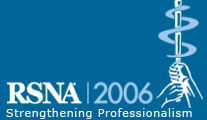
Abstract Archives of the RSNA, 2006
Mitsuru Yahata, Abstract Co-Author: Employee, General Electric Company
Yasuhiro Imai MS, Presenter: Employee, General Electric Company
Haruo Kurochi MS, Abstract Co-Author: Employee, General Electric Company
Takashi Fujishige MS, Abstract Co-Author: Employee, General Electric Company
Masatake Nukui MS, Abstract Co-Author: Employee, General Electric Company
Kentaro Ogata MS, Abstract Co-Author: Employee, General Electric Company
To develop novel high-resolution multislice CT with the high-density matrix detector through current CT detector technology and the ultra-small focal spot tube, and to evaluate its basic performances and showed clinical possibilities.
We targeted at double spatial resolution for both X and Z directions comparing with current our 912-ch * 64-row * 0.625mm volume CT (VCT), and also keeping current VCT’s basic specifications like 50cm field of view , gantry rotation speed and so on.
We developed new detector using the back illuminated type (Backlit) photodiode to realize ultra high-density matrix, and also developed new tube with ultra-small focal spot size using new technology to maintain same power with considering clinical use. These new detector and tube were mounted on the current VCT gantry, and we evaluated basic performances using specific phantoms, and clinical possibilities using head and coronary with stent phantoms.
ATF simulation showed detector needed half size for both x and z direction of detector cell and tube needed 0.35mm width (IEC standard) focal spot size to achieve the target, so that, the detector was designed 1824ch * 32-row * 0.3125mm (10mm for z-coverage), and the tube focal spot size of tube was designed 0.35mm width with 335mA max. Proposed system visualized 0.19mm (26lp/cm) , and showed 18lp/cm at 50%-MTF and 27lp/cm at 10%-MTF. These values were about double resolution comparing with the current VCT. On the other hand, proposed system had comparable low contrast performance with the current VCT. Head bone tissue was visualized extremely high-resolution, and also 2.5mm stent lumen was clearly showed with standard reconstruction kernel.
We developed a very high-resolution CT, which has features of not only double high contrast, but also comparable low contrast performance with same major features as the current VCT. This has great possibilities to change current CT diagnosis. (This is supported by garnt of the NEDO established by Japanese Government.)
This CT has a high possibility to meet to recent request for higher resolution on the Cardiac Coronary Artery examinations.
Yahata, M,
Imai, Y,
Kurochi, H,
Fujishige, T,
Nukui, M,
Ogata, K,
Very High-Resolution Multislice CT Development. Radiological Society of North America 2006 Scientific Assembly and Annual Meeting, November 26 - December 1, 2006 ,Chicago IL.
http://archive.rsna.org/2006/4434776.html

